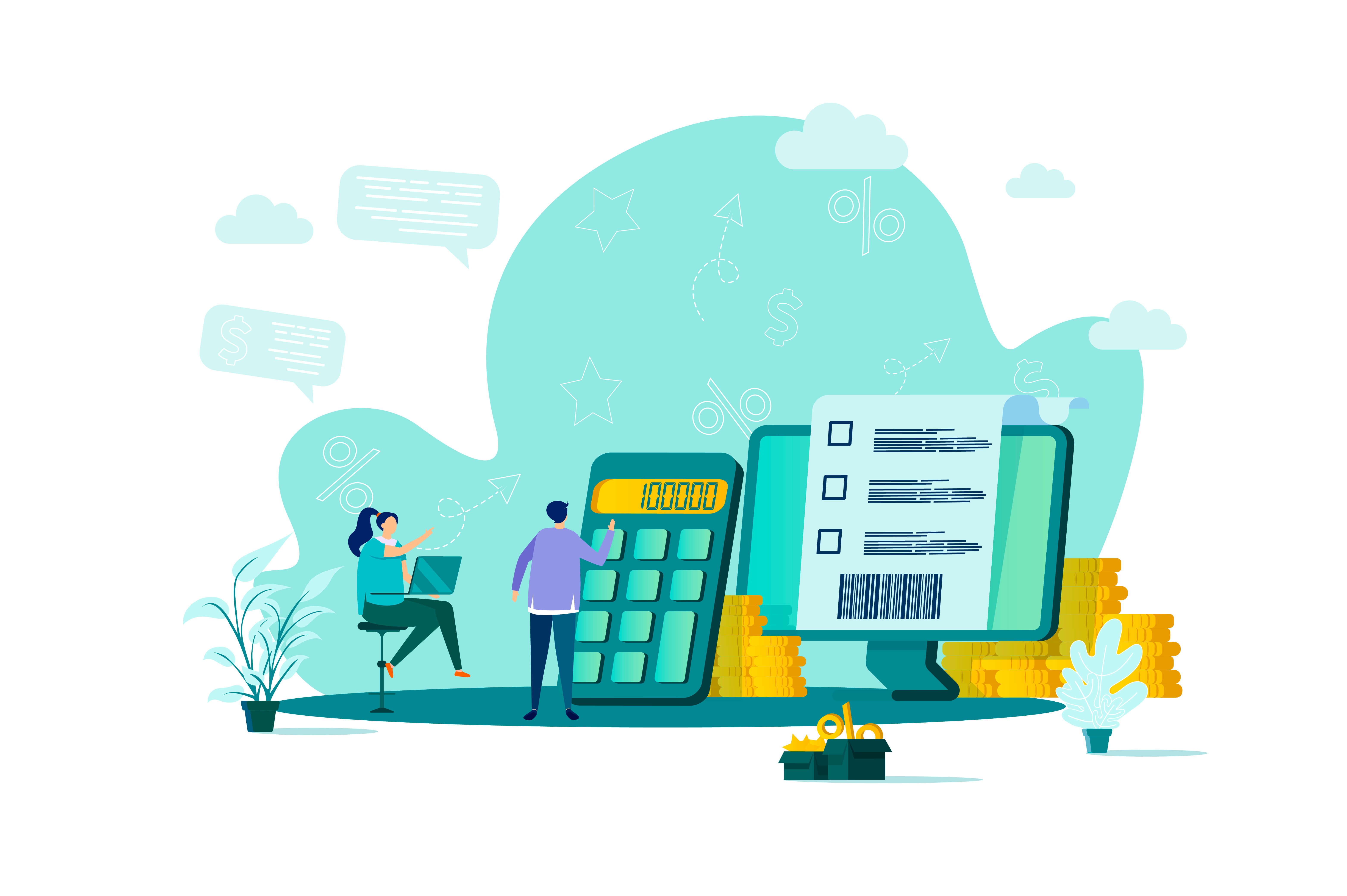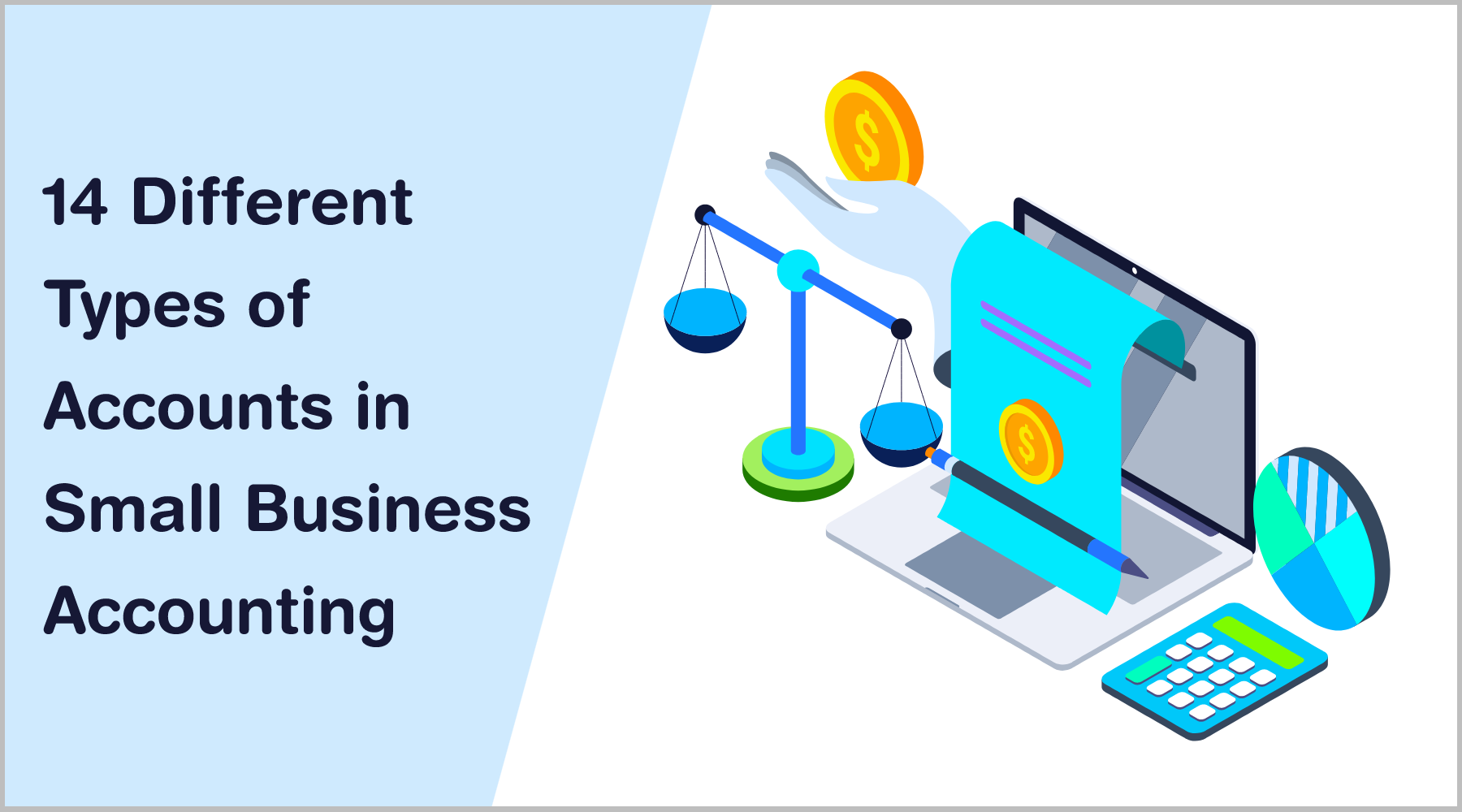If a small business wants to expand its operations, it needs to have enough data to ensure successful expansion. What is that data, you ask? It’s the financial statements. As a business owner, it is your responsibility to keep track of the money that goes in and out of your business account. Business accounting is a basic term for a small business. Then again, many business owners fail to understand the types of accounts in small business accounting.
Since accounting is an administrative task and business owners should keep in touch with bookkeeping, accounting software, and business expenses, it’s important for small businesses to know about accounting.
But first, let’s start with starters.
Small Business Accounting

Small business accounting is a process of keeping track of all the transactions happening in your business accounts and analyzing the information later for your company’s long-term improvement.
As a small business owner, tracking down all the business accounts and the company’s assets can be hard. So what you need to do is hire an accountant and set up accounting software. This way your accountant can easily track all the sales, liabilities, and cash flow in and out.
Now that you know what accounting is, let’s jump into the type of accounts.
A Step-by-Step Guide to Small Business Succession Planning
14 Types of Accounts in Small Business Accounting
- Asset Account
- Liabilities Account
- Equity Account
- Income Accounts
- Expense Accounts
- Accounts Payable
- Accounts Receivable
- Foreign Exchange Accounts
- Cash Accounts
- Bank Accounts
- Health Spending Account (HSA)
- Accounts for Goods Sold
- Enlisted Credit Cards
- Undeposited Funds

Yes, you read the heading right. In reality, there are more than just 14 types and five categories but still. I don’t think you’ll be needing the miscellaneous ones. So take a look at this chart of accounts.
1. Asset Account
Every company has a different set of assets that adds value to your business. It can be a physical or cloud resource. You can keep a single account or create sub-accounts in your system.
Assets are important to adjust the balance sheet and sales tax return. All of your assets, liabilities, inventory information, and accounts receivable data will be kept in this account.
2. Liabilities Account
If your business owes money from a bank or you’re in debt then all those credit and cash will be acknowledged as your company’s liabilities.
Debt can be of different types, you can be in a short-term debt where you have borrowed a limited amount of credit. Or, you can be in a long-term debt where you took a 5 to 10-year loan. Also if you have taken prepayments from customers and you’re yet to deliver the product to them, that is also called liability.
Ask your accountant to drop down all the expenses, payments, taxes in the accounting software so you can maintain and fulfill all the debt. Keep them in the accounts payable section so you won’t lose track.
3. Equity Account
As a business owner, you have definitely invested a good amount of money in your small business. Or maybe you’re a sole proprietorship who gathered enough capital to start the business. Both ways, the owner’s equity needs to be kept in the general ledger or in the equity account.
Amongst all the other types of accounts in small business accounting, you need to set up the equity account at the very beginning because using the equity account you can track your company’s financial income statement and measure the equity revenue. This will help you to plan the next year’s budget using your retained earnings.
4. Income Accounts
Many businesses tend to fail in the bookkeeping process. For small businesses, it is highly necessary to maintain the cash flow of their revenue because they are always struggling in their growth stage.
In this stage you will generate a lot of money, your business can open multiple bank accounts because, for multiple income sources, a single bank account won’t help.
All you need to do is ask your accountant to use the accounting method called accrual accounting. This way you can trace all your revenue in one place.
5. Expense Accounts
It’s not always about generating money, right? You have to go through our business expenses as well. For different types of expenses try using separate bank accounts.
List down the chart of accounts by sales tax, office supplies, assets and liabilities, general tax, miscellaneous expenses, and employee salaries. Categorize your expense accounts so you don’t lose track.
Similar to income accounts, accrual accounting will help you to trace your expense accounts as well. So you can use this too.
6. Accounts Payable
When you use accounting software to keep track of everything, it starts to calculate all the dues and then notify you to pay them on time. Accounts payable is basically a bag full of expenses that you forgot to pay.
If you forget to pay your dues, it will hamper the other types of accounts in small business accounting.
7. Accounts Receivable
When you start making sales but you’re yet to receive the cash from your customers, that’s called accounts receivable. Your accountant has a list of invoices in the accounting system that the company is yet to receive.
It’s important for businesses to collect all the money from their customers as soon as possible. If you credit too many invoices then it might invite major financial issues for the company. So don’t let that happen.
8. Foreign Exchange Accounts
If your business supplies products outside your country and earns foreign currencies, you’ll need a different bank account to record that revenue. Foreign currency bookkeeping is very crucial because you will be trading in foreign cash.
In terms of foreign invoices, you’ll have to go through sales taxes, import and export taxes, this means the local payment bill and the foreign payments will be different from each other.
You might need to create separate types of accounts in small business accounting to deal with foreign issues. Do make sure those accounts are relatable to your foreign exchange.
9. Cash Accounts
Cash accounts are used for bookkeeping all the basic financial cash flow of the company. This includes taxes, expenses, standard income, deposits in your local currency. You can set up multiple cash accounts to deal with individual expenses.
10. Bank Accounts
All the custom cash account, checking account, savings account or credit card accounts will be meaningless if it isn’t linked up with a bank account. It is always a good idea to keep all accounts attached to your bank accounts to store everything in a safe place.
You can have different accounts in the same bank or in different banks. Just make sure your accounts include your business name instead of yours.
11. Health Spending Account (HSA)
Being the sole proprietorship of your own company you would want to spend a happy life after your retirement. There’s no point in having all these types of accounts in small business accounting if one of them doesn’t think about the owner itself, right? But to do that you need to take preparation from an early stage.
The health spending account is more of a tax plan that tries to resolve all your personal tax issues and turn your medical expenses into business deductions. An insurance account is now a traditional thing while the HSA is an evolved version of it.
Using this account you can easily remove incoming taxes to secure your insurance plan. It won’t be a good idea to open an HSA account months before your retirement. Try opening it earlier to prepare accordingly.
12. Accounts for Goods Sold
Should you open multiple bank accounts for all the goods sold? It entirely depends on how many products you sold and in how many areas.
To sell a product you’ll go through three phases, the Collection phase, production phase, and distribution phase. Either way, you need to have a general ledger of everything that is happening.
Also if you are shipping your products outside then start bookkeeping that as well.
13. Enlisted Credit Cards
Forget about the other types of accounts in small business accounting because credit cards are the smartest ones.
The world is moving towards a cashless generation. You might have a cash account for your business but most of the transactions are made through credit cards.
The credit cards account reflects the accounting method where all the financial payments and bookkeeping are done through credit cards. This is important for all small businesses as they are to face financial challenges.
Moreover, a credit card will help you to keep track of all the payments and expenses.
14. Undeposited Funds
Long before the existence of mobile banking or physical banks, businesses used to trade money through envelopes. Even back then, loans used to exist and everyone used paper and pen to record all the transactions. But now things have changed.
All the loans and one-sided transactions are now accounted as undeposited funds. Now you can deposit all your payments through banks or transfer the money from one account to another. By doing this, you are allowing money to be transferred to the right accounts through your institution.
So these were the different types of accounts in small business accounting. Hope this will help you to organize all the financial statements of your business.
Now that you know almost everything about the types of accounts, it’s time to learn how to set up the bookkeeping process in your company. So let’s get to it.
Step by Step Guide to Small Business Accounting

There is always a lengthy process and a short process in the small business accounting method. I will try to stay somewhere in between so you don’t miss the important terms.
Select an Accounting System
Is it a fresh new business or has it been in the market for a year or two? Your accounting system will determine the difficulty level of keeping track of all the money that goes in and out. Mainly there are 2 types of accounting systems. The traditional approach and the automated approach.
The traditional approach refers to manual systems. Here you and your accountant will use papers and spreadsheets to note down everything. The issue with the manual system is that you’ll need to conduct all the analysis by yourself and ensure the balance in the end.
In the automated system, you’re going to use accounting software. All you need to do is type in all the details and data in the accounting software and it will start to analyze all the results on its own. It will calculate your credit, income, and expense and provide you with financial reports.
Everyone would choose the automated system over the manual system which is very obvious. But if you are an organization that has just started its journey, then you should use the manual system and start playing with spreadsheets.
Open a Bank Account
The bigger your business is the more accounts you’ll need. The smaller your business is, the lesser the account numbers will be. Either way, you’ll need a bank account for your business.
Don’t mix up your personal income and expense account with your company’s bookkeeping and payments account. You need to keep them separate from each other.
For a small business, a bank account will be your go-to tool for all your financial issues.
Choose a bookkeeping method
In case you don’t know, bookkeeping is the process of keeping a record of all the financial affairs of your company. This even includes your institution tax.
There are two types of bookkeeping methods. Single entry and double entry. The difference between these two is that you use one account in a single entry and two accounts in a double entry. That’s it.
The single entry method follows the rules of cash accounting. It focuses on receiving money and payments. The double-entry method follows the rules of accrual accounting. It focuses on recording the outcome.
If your business is too small and you don’t have to worry about your inventory management, choose a single entry. If your business is at its growth stage and you have serious inventory management then choose the double-entry method.
Employee Payroll Management
Your employee’s salaries also count as your business expenses. It doesn’t matter how much your income is, you’ll need to keep your employees satisfied with the payroll. If you don’t know how to set up their wage then here’s the process.
First, check the minimum wage according to the labor law department. This will help you to stay on the safe side. Then use the employer identification number to verify the identity of an employee.
Next, pick a range of salaries for your employees and keep them documented. Finally, you need to create a separate spreadsheet of your employees to maintain the payroll.
Trace your Business Expenses
Like mentioned before, you’ll need to invest a lot of money in your business every month. Tracking down your business expenses is a must. If not you’ll see your income level is going in the wrong direction.
To track down all the expenses, try keeping all the receipts in one place. Use accounting software to store all documents. This will surely help.
If you don’t know what your expenses can be then here are a few examples. Meetings expenses, business travel, vehicle expenses, inventory cost, office rent, employee payroll, and miscellaneous bills. These are the common ones, although business expenses differ from one institute to another.
Hope this gives you a clear idea regarding your business expenses.
Start Making Journal Entries
Journal entries are like a double-entry bookkeeping method. The rule is you need to keep everything recorded. I know you have accounting software for that but the journal entry has its own uses.
Journal entries are like activity logs, you just write down everything you do with your income and expenses so you can take a peek later.
Enter your transaction number, journal entry date, accounts info and you are good to go. Of course, you’ll note down how much you debit and credit each day, that’s very obvious.
Learn more about taxes
Every company needs to open a tax account in the name of its business. If you’re in a common stock agreement then it will be easy for you.
In terms of employment, there are four tax methods. Federal withholding tax, social security tax, state withholding tax, and local withholding tax.
The federal withholding tax would cut off a certain amount from the employee’s wage. The social security tax doesn’t have any fixed amount and is controlled by the IRS.
The state withholding tax is all about the state where your business is located. Lastly, the local withholding tax focuses on the city or town your business stands upon.
Engage with a lawyer and start making documents if you don’t want to get into trouble.
Earn Business Credits
Small businesses should focus more on business credit because then they can benefit from it. To build business credits, you’ll need to go through a procedure.
First, you need to build a good relationship with your vendors, that way you can create a line of credit.
Next, you need to acquire a business credit card so you can pay for your business expenses in the easiest way.
Keep your personal credit card value high so you can gain a higher business credit card score. This way all your transactions will be smooth.
So this was the process to set up accounts for your small business. I hope this will help you to organize your income, expenses, and sales tax in one place.
